Menus
- Baby GS: the Trail is back
- Discovery
- In the saddle
- Contact
- In the city
- Highway
- Departmental
- National
- All Terrain
- Comfort
- Braking
- Practical aspects
- Conclusion
- The video test of the BMW G310GS
Baby GS: the Trail is back
Paradox. It is by imposing its "flat" on the Paris Dakar, that BMW has shifted the market from mono to twin, causing the disappearance of small trails in the 90s. Almost 40 years after the arrival of the 80 GS, the propeller brand therefore makes us the big comeback of a model that is at the same time simple, light and hyper-versatile. History is an eternal restart! But quite philosophical, let’s discover the youngest, who shares his heart with the G 310 R.
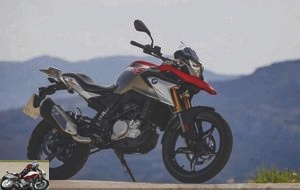
Discovery
The family resemblance is undeniable. We are really dealing with a GS. From certain angles the resemblance is striking and despite its small displacement, the small one imposes it, without wanting to be made bigger than the ox. At first glance we appreciate the robust tubular trellis frame associated with a very long foundry swing arm. Radial braking, large inverted fork, large travel and quality finish make this 310 a real BMW and not a by-product for emerging markets.
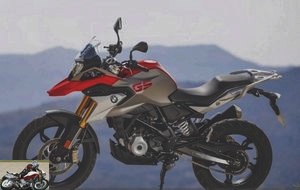
Admittedly an informed eye will quickly detect "small savings" intended to contain the cost price within reasonable limits (or not): the absence of adjustment of spacing on the levers, the rear suspension without rocker which actuates a combined or only the spring preload is adjustable. there is also the absence of warning and handlebar control for the on-board computer. The foundries of the engine or the wheels do not have the grain of the S1000 RR, but nothing cheap and young allowed or less young, the biker can be proud of his steed.
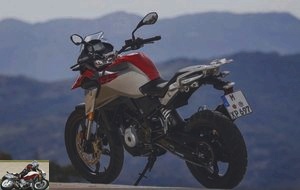
This is all the more true as this 310 has an engine with the reversed cylinder head and the tilted cylinder for the less original! A refinement which makes it possible to advance the crankshaft axis as close as possible to the front wheel, for better handling and also to lengthen the oscillating arm for a rear suspension that works better and thus does very well without the rocker! Finally, the intake placed in front takes fresh air at the source, then the exhaust placed behind no longer heats the legs of the pilot by passing to the side. A process already used in TT by (fire) Cannondale, Yamaha and in speed on the Petronas superbike.
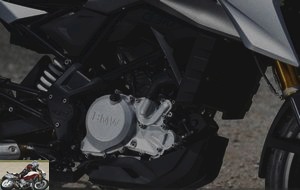
In the saddle
Perched at 835 mm from the ground, we take advantage of the narrowness of the bike to put our tiptoes on the ground without too many problems, as long as we exceed 1.70m. For the little ones there is a low saddle option and an even higher saddle for the older ones. With 169.5 kg fully loaded, the bike is easy to handle, especially as the wide handlebars reduce the effort to maneuver.
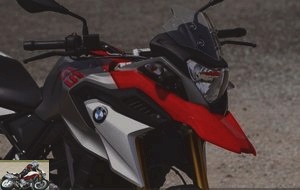
The small dashboard is complete and easy to read. As long as you let go of your handlebars, the on-board computer will show you the average and instantaneous consumption, the residual autonomy, the average speed, the date, the time, the gear engaged, the engine temperature, the level of gasoline and even two trips! The mirrors are efficient and rubbers protect your dress shoes if necessary. Indeed, for the TT, they are notched. You are ready, we start?
Contact
The sound of the small mono (313 cm3) is not the most virile. There is hardly that beyond 6/7000 rev / mn that the noises of admissions coming from the airbox come pleasantly enhance the sound atmosphere. Below, the mechanical noises are quite present, probably slamming of the piston skirt against the liner. Nothing unpleasant, but it’s not the melody of happiness that more manly mechanics can offer. Either, we are on a small mono and you can hear it. Hop, hop we grab the levers, a little far apart and we go first to get started.
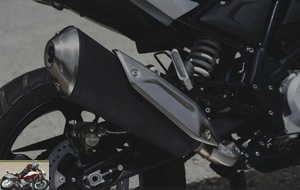
In the city
Patatras, when taking off, we stall. Not that the engine is not running smoothly, it’s just because of its low inertia and the lack of torque below 3000 rpm. With practice, we get used to it, but at the very beginning, it is a bit surprising. Hopefully it won’t put off the novices. After this (very) small inconvenience, we enjoy a light motorcycle, manoeuvrable, not too high and which steers wonderfully. Sitting high up, we sneak around with a good overview. We take advantage of the efficient mirrors and the smoothness of the controls. Discreet, the motorcycle will be an excellent companion for your daily journeys. On the first reports, the engine does not bang excessively for a mono, on the other hand, in sixth, avoid going below 3000 rpm. Otherwise, he quickly shows his disapproval.
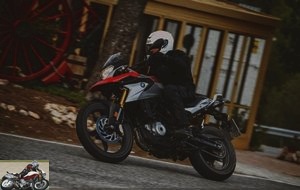
Highway
The time has come to let go of the horses and here the baby GS will be willing, as long as you whip him. After 6000 rev / min, it sets off in beautiful flights and you will not have the slightest problem to follow the traffic. During a small acceleration, we saw 148 km / h on the odometer, while there was still a little reserve. BMW announces 143 km / h chrono. Frankly, it is never penalizing and the 34 hp announced are present, even if they are installed high in the stable. It would be a shame to consider a Paris Marseille in this mode, but for short trips, no problem. As for protection, it is adapted to the vocation and performance of the motorcycle..
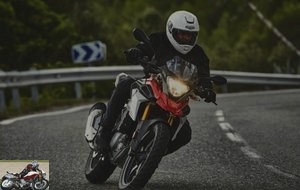
Departmental
This is clearly his favorite field. If it’s bumpy and spinning, you’re in for a treat. The 180 mm front / rear travel are marvelous, especially as the suspensions are flexible. The speed bumps present in all the villages are much less unpleasant than with a road. You can even play gas jump them to pass the time.

The very balanced cycle part is a treat and the grip offered by the Metzeler Tourance gives the driver enormous confidence. No BMW didn’t pull out an old tire from behind the bundles. This Tourance is specially developed for the GS 310. It benefits from a softer nylon belt (instead of steel) and a softer rubber mix. Combined with a 19-inch front wheel and 150-inch rear tire (which we still found recently on 1000cc trails!), They provide excellent grip in the dry and provide good feedback. In fact, in these conditions, the small GS displays a sporting potential as pleasant as it is efficient..
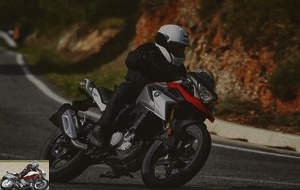
National
When the horizon widens, the 310 GS is not struggling, its performance is largely sufficient, even if one imagines, without having tested it, that in duet and loaded, it will be necessary to strongly solicit the mechanics. to keep a good pace. Stability remains excellent at "high speed" and the 19 wheel is, as always, an excellent compromise between handling / pleasure / performance..
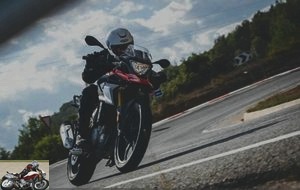
All Terrain
By dint of rolling on "trails" of 250 kg and more, we had almost forgotten that we can have fun in the small paths, by sliding from the back, or by skipping the channels (I’m kidding). Here we find all the versatility of the trails of yesteryear like DR 350 or 500 XT, with good travel. The setting of the suspensions promoting comfort is correct, for a pilot not too heavy (65/70 kg) and a reasonable pace. If it is to play the victory at Bercy, it will follow behind.
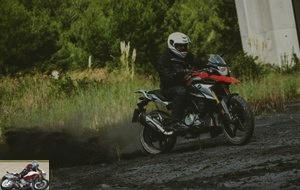
The standing position is comfortable and for more safety you can very simply disconnect the ABS. We would have liked to have been able to remove it behind and keep it in front, but this is not planned. On more difficult terrain, the crossing capacities remain correct. The Tourances have beautiful paving stones and the ground clearance is sufficient for this use. Be careful though, the protective shoe is plastic! In short, we can really have fun without risk going off the beaten track.
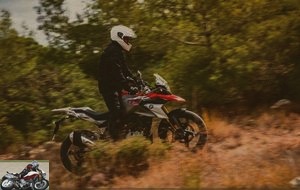
Comfort
Flexible suspensions, large deflections, ergonomic position, well-designed saddle, a little vibration, but of low amplitude, contribute to a correct result. We only covered 160 km during the day, but associated with the overall lightness and ease, these qualities make the GS a highly recommended companion..
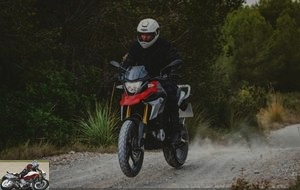
Braking
A 300 mm disc, a 4-piston radial Bybre caliper ("By Brembo" made in India) are more than enough to stop the 169.5 kg of the beast and its pilot launched at 140 km / h. ABS does the job, never triggering unnecessarily, even in sporty driving on dry ground. Its activation / deactivation is very simple.
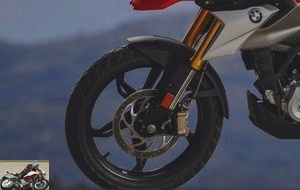
Practical aspects
The selector and the brake pedal are made of sheet metal. It is less pretty than aluminum, but it twists and straightens in the event of a fall.
Consumption seems very reasonable, around 3.5 L / 100 in normal driving. With a little attention, the 3Ls are within reach. With the tank capacity and the indications on the dashboard, you can drive serenely and at a reasonable budget. The original equipment also includes a solid luggage rack, this is to be taken into account.
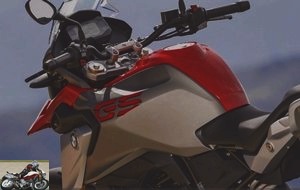
Conclusion
Offered at € 5,900, the 310 GS is the only true small-capacity trail, but its price is not cheap. Logically, we do not expect to find a BMW at the price of a Mash Adventure and the quality of the product is indisputable, fortunately for BMW, competition is limited in the segment. The Honda CRFL 250 is more enduring and less powerful, even in its Rally version. More road the Kawasaki Versys-X 300, is displayed 100 € less and the Japanese twin offers 6 hp more. A Kawa which plays a little in the same court as the Suzuki V-Strom 250. Finally its most worrying competitor, if we fall for a small qualitative displacement, but not necessarily on a trail, it is the G 310 R , also very convincing and offered for 950 € less.
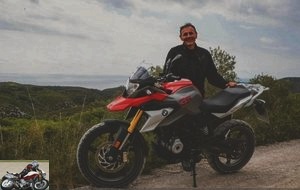
Strong points
- Versatility
- TT aptitutes
- Finishing
- Comfort
- Braking
- Economy of use
Weak points
- Tariff vs. G 310 R
- Lack of torque below 6000 rpm
- Non-adjustable levers and too far apart
- Low noise
- No dashboard controls on the handlebars
- Lack of warning and tool kit
The technical sheet of the BMW G 310 GS
Test conditions
- Itinerary: 160 km of national or departmental roads, mountain, connecting motorways, small towns and all roads
- Motorcycle mileage: 597.5 km at the start
- Problem encountered: none
The video test of the BMW G310GS
Related articles
-
Fine-tuning in order You don’t change a recipe that works. The second generation of the Ducati Diavel therefore evolves only on points of detail while…
-
Harley Davidson Street Glide "Rushmore" test
The Harley Bagger Project Rushmore : the 2014 Harley range The best-selling model of the Harley Davidson range in the world, the Street Glide is…
-
399 cm3, 41 hp, 3.5 m / kg, 167 dry kilos, € 7,990 A variation intended for young people allowed, beginners, followers of the lifestyle… [scram-bler]:…
-
Ducati Scrambler Cafe Racer test
A more sporty version of the Scrambler with a neat look The Scrambler V2, 803 cm3, 75 hp at 8,250 rpm, 68 Nm at 5,750 rpm, 172 kilos, € 11,290 About 2000…
-
Harley Davidson Ultra Classic and Ultra limited Rushmore test
Harley Davidson takes the plunge (and us with)! In the increasingly competitive world of luxury GTs, Harley Davidson is redesigning its copy and…
-
Harley-Davidson CVO Street Glide 114 test
V2, 1868 cm3, around 100 hp, 165 Nm, 398 kilos with full fuel, € 39,550 A certain vision of the exception made in Milwaukee and a really punchy 114…
-
Harley-Davidson Sportster S Test
Haters gonna hate… VTwin Revolution Max 1250T, 1,252 cm3, 121 hp, 125 Nm, 228 kg in running order, from € 15,960 This is a machine that will appeal to…
-
Waiting for the new Hornet… No, the CB 650 F is not the replacement for the Hornet. Healthy, easy and fast enough, it is intended primarily for…
-
In-line twin, 471 cm3, 45 hp at 8,500 rpm, 44.6 Nm at 6,000 rpm, 190 kilos, € 6,299 A small accessible bobber intended for A2 licenses on a mechanical…
-
Little pearl of Asia Introduced in 1984, the Honda 500 VF came at the start of the wave that saw Honda bet everything, or almost everything, on this…